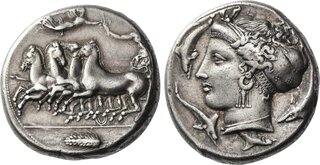| Numismatica Ars Classica > Auction 146 | Auction date: 8 May 2024 |
| Lot number: 2112 Price realized: This lot is for sale in an upcoming auction - Bid on this lot  | Show similar lots on CoinArchives Find similar lots in upcoming auctions on |
| Lot description: Syracuse. Tetradrachm signed by Eukleidas circa 405-400, AR 25 mm, 17.15 g. Fast quadriga driven l. by female charioteer, wearing chiton and holding reins in l. hand and flaming torch in raised r.; above, Nike flying r. to crown her. In exergue, ear of barley. Rev. [ΣY – RAKOΣIOΣ] Head of the nymph Arethusa l., wearing triple pendant earring and necklace; hair waved over the crown of head and enclosed in sphendone ornamented with stars and knotted over the ampyx. Around, four dolphins, the one below the chin with signature EYKEI. Rizzo pl. 43, 20 and enlarged pl. 46, 4 (this reverse die). Boston, MFA 410 (these dies). Gulbenkian 281 (these dies). AMB 463 (these dies). Kraay-Hirmer pl. 38, 110 (these dies). Tudeer 57. Coins, Artists and Tyrants 57k (this coin). Extremely rare and among the finest specimens known. A portrait of Arethusa of enchanting beauty, undoubtedly one of the finest of the entire series, the work of a very talented engraver. Struck on very fresh metal and on an unusually large flan and with a light old cabinet tone. The usual die break on the cheek at a very early stage, otherwise extremely fine Ex New York sale III, 2000, 100. Emanuele Rizzo wrote: "Kimon is a great master engraver, Eukleidos is the greatest, not even surpassed by Euaineos, because the coins struck from his dies, if well-struck, well-preserved and well photographed, do not lose the clarity and the plasticity of their form even when enlarged several times" (E. Rizzo, Saggi Preliminari sull'Arte della Moneta nella Sicilia Greca, Roma 1938). Rizzo refers to this tetradrachm as "La bella di Eykleidas", considering it to be the artist's masterpiece and the most beautiful Sicilian coin, or at least the most beautiful of the Classical period. Of this mythical coin only a few specimens are known. Tudeer lists only ten specimens, most of which are in public collections. Up to today, the finest specimen known, beyond doubt, is that of the Pennisi collection, published and enlarged several times by E. Rizzo and many other authors. This coin has been auctioned twice: by Munzen and Medallien in its auction 72, 1987, lot 530 and by Leu in its auction 81, 2001, lot 107. This coin has, like all the known specimens, a die break on the cheek of Arethusa, starting from the earlobe carrying on towards the mouth, affecting almost all of the cheek (in the photos published by Rizzo, which were taken not from the coins but from casts, this defect cannot be seen because it was his practice to remove such faults from the cast). The die break, in the example here offered, is in its initial stages. Undoubtedly, amongst the known specimens, this is the one on which this annoying and inaesthetic flaw is less evident and it is also the one in finest condition. The narrowness of the flan, which could appear as a fault, made possible an exceptionally high relief and an incomparable clearness of details. Estimate: 60000 CHF |  |



